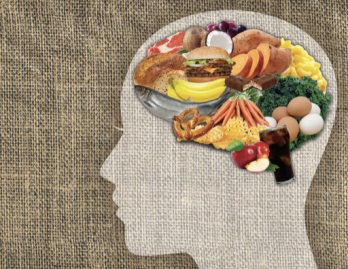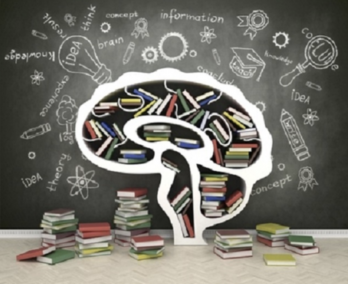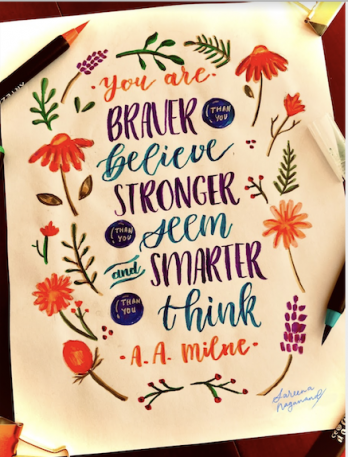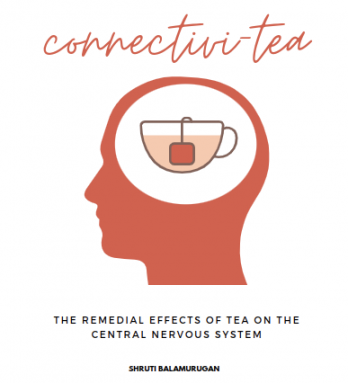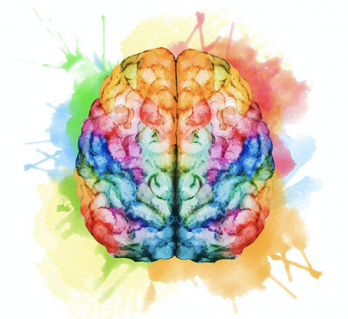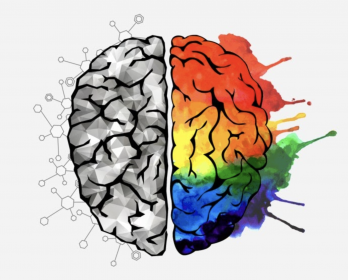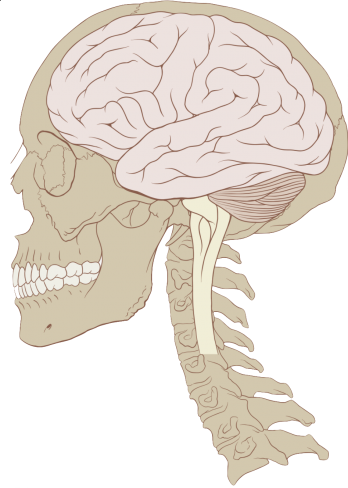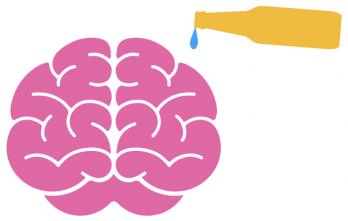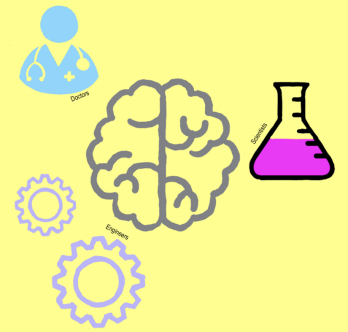GRRR! You hear a loud growl coming from your stomach, and you look right at your clock. Time to eat!
[…]The following blog is an honorable mention in the Brainy Blog Competition.
For the past 6 months most of us have been stuck indoors. Many of us have used this time to pick up new hobbies, or continue hobbies that got swept to the side due to a busy work or school schedule. Well, I fell into the latter category.
Over the past 6 months, I’ve read over seventy books! This might seem like an overkill, but I absolutely love to read.
There are many reasons why I read so much. One reason is that I enjoy conceptualizing ideas and thoughts through the eyes of different people from the words they write. Another reason is because I know that reading utilizes multiple parts of the brain and requires a degree of focus and memory to be done fluently, with full comprehension of what is being read. It is a great way to exercise the brain, similar to the way you exercise your muscles at the gym, keeping our brains active and alert.
An article published by Harvard University called “Reading and the Brain,” by Scott Edwards breaks down the process of learning to read that starts from the time that we’re born. Edwards described how babies start processing sounds and developing phonological skills, the ability to discern the sounds of a language, as they grow into toddlers. He described how the act of reading requires the brain to recognize words, recall the meaning of those words, understand the context of those words in a sentence, put the ideas formed by those sentences in a paragraph, and comprehend the information given by those paragraphs into a story or narrative. These many many steps in the reading process are why reading takes several years of practice to be done fluently and is a definitive way to work your brain.
Many of these steps require different parts of the brain. Scientific American published an article called “The Reading Brain,” outlining the functions of different parts of the brain in regards to reading and language. Tanja Kassuba and Sabine Kastner, the authors of this article, described the occipital, temporal, and parietal lobe in the brain’s left hemisphere as parts of the brain that contain a person’s wordbox. The wordbox was defined in this article as the part of the brain that connects the brain’s visual system and language regions. This section of the brain takes the shapes and lines that form words from our brain’s visual system and delivers them to the brain’s language regions, where those shapes become words with a given meaning that can be interpreted.
As we read, our brains connect our memories and experiences to the ideas set in each sentence, using them as a foundation to put together a scene in our heads. It’s amazing how every language we learn requires so many parts of the brain to function. This is a great example of how many different parts of the brain work in tandem. So whenever we read, our brain comes alive with the various signals that are working together to interpret the lines and shapes we see and give them a meaning, a life, and a story.
Author: Rebecca-Renee Lorente
The following blog is a winner of the Brainy Blog Competition.
Ever since mankind has learned how to write, it has become a fundamental part of our history — manifesting into an intricate art, in some cases. We see this in historic empires, namely the Islamic Empire, where Arabic handwriting branched into a unique form of Arabic calligraphy and has since been used to spread religious messages. Similarly, calligraphy and brush lettering have been prevalent in Japan and China since the medieval ages. As we approach the modern era, we’ve seen more distinct forms of calligraphy and hand-lettering, such as the classic ‘old English letters’. Personally, hand-lettering has played a major role in my life; it has served as a hobby and a source of therapy. I find the greatest pleasure in bringing ordinary words to life with different strokes and embellishments — as displayed in the image above. Similarly, I am often guilty of redefining my calligraphy style in school notebooks and worksheets.
However, recent observations have proven that practicing hand-lettering has the ability to improve brain function. Specifically, handwriting — and thus hand-lettering — increases language processing skills. The ability to process language is controlled by multiple areas of the brain. For instance, the Broca’s area — located in the frontal lobe of the brain — is linked to speech production and language comprehension. Further, the Wernicke’s area — located in the cerebral cortex — is involved in understanding written and spoken language. In fact, according to a study performed at the Indiana University, the action of writing by hand increases neural activity in these areas of the brain — much like meditation (as shown by high-tech resonance imaging). It also unleashes creativity not easily accessed in any other way.
The reasoning behind these results is substantial. When a person practices handwriting (as supposed to typing), they are taking the time to absorb — and process — what is being written. It is a slower process, and hence a more beneficial one. Handwriting is a complex task that involves multiple visual perception skills such as eye-hand coordination (the ability to coordinate eye movement with hand movement), visual discrimination (the ability to classify objects or shapes based on visual information) and position in space or spatial relationships (the ability to process information about oneself in relation with their environment in space, orientation, and position). Put in more simpler terms, while handwriting requires us to transfer our thoughts on paper, it also requires us to analyze other factors like size, propritions, and spacing; the intertwinement of these two distinct processes is what enhances mental cognition.
Even though these studies are predominantly centered around day to day handwriting, the same findings can be applied to hand-lettering and calligraphy, as well. When creating a hand lettered piece, the same visual perception and planning skills are employed. In the process of transferring a phrase on paper, the artist is forced to consider artistic elements — such as format, fonts, and stroke size. Because more time and effort is utilized in forming calligraphy letters, the resulting phrase is absorbed and processed better; compared to normal handwriting, hand-lettering increases neural activity further. Whenever I need to remember something important, such as a quote, I turn to my brush pens and “calli-grafy” it — doing that seems to store the phrase in my brain for a very long time!
In summary, hand-lettering is an increasingly popular art that has taken numerous forms throughout time. However, this intricate and historic art is sometimes overshadowed by the prospect of typing — which has made transferring thoughts on paper effortless. Nonetheless, hand-lettering has proven to have significant value; while being a form of art and relaxation, it also increases neural activity, improves language processing, and enhances visual perception skills. I have full confidence that as time progresses, hand-lettering and calligraphy will continue to be treasured.
The following blog is a winner of the Brainy Blog Competition.
In Santos, Brazil, coffee is referred to as Humanities Favorite Drink. To many people, that sounds very plausible, however, it is not the truth. In actuality, the world’s favorite drink- excluding water- is not coffee, as the children of Brazil learn at an early age. it’s not Coca-Cola- which many American kids hear in childhood. it’s not even alcohol, which can hook drinkers for life through addiction. it’s tea.
Surprised? I sure was. From earl grey to chamomile to chai, tea has been around since 2700 B.C., predating coffee by about 3000 years. There are many reasons as to why tea has remained favorable for a great amount of time. For many, the reason is that tea is rooted in their culture. As for others, it’s a specific taste that coffee cannot provide. For most, though, tea is most popular due to its medicinal values. The drink is brimming with antioxidants, flavonoids, and other biologically active substances, such as polyphenol, theaflavins, caffeine, and theanine, which gives tea its astringent and fresh taste. However, that is not the only purpose of those substances. Teas are also known to have effects on neurological function, and, as emerging studies show, neuroprotective effects that decrease the risk of getting neurodegenerative diseases such as Parkinson’s, Alzheimer’s, and general cognitive decline.
A new study led by the National University of Singapore, and published in Aging, shows evidence of the rise of both functional and structural neural connectivity in correlation to drinking tea. After conducting experiments with adults aged 60+ using magnetic resonance imaging (MRI) and neuropsychological testing, the researchers found that those who drank green tea, oolong tea, or black tea at least four times a week had brain regions that were interconnected in a more efficient way.
“Our results offer the first evidence of positive contribution of tea drinking to brain structure, and suggest that drinking tea regularly has a protective effect against age-related decline in brain organization,” said Dr. Feng Lei, a researcher in the Department of Psychological Medicine at NSU and the lead author of this study.
The research shows that tea opens up several pathways for the prevention of neurodegenerative diseases like the ones listed earlier. With the accelerated aging population in the world, the prevalence of neurodegenerative diseases such as Parkinson’s and Alzheimer’s are increasing over time reaching roughly 1.3 million people over the age of 65 in 2020. With this emerging research, however, there’s a chance that these diseases may be preventative for some time. In other words, there’s a chance they may be able to slow down significantly.
In this recent decade, many studies have proven that tea has neuroprotective functions. According to one Ohsaki Cohort Study, which spanned 5.7 years and involved 13,645 Japanese, over the age of 65, green tea consumption significantly reduced the risk of dementia. Another study led by Shu-Qing Chen et.al. states that large amounts of evidence have indicated that tea polyphenols (reducing agents known to protect the body against oxidative stress) play a neuroprotective role in neurodegenerative diseases through antioxidation and the regulation of signaling pathways.
Even with all this, there is so much more to tea. Theanine is a unique amino acid of tea, accounting for 1–2% (dry weight) in fresh tea leaves. Numerous studies have shown that theanine has a neuroprotective effect. For example: glutamate is the most widely available excitatory amino acid in the central nervous system and involves many important physiological functions in the brain. When in a certain concentration, any neurons exposed to the glutamate will undergo cell death, as Nozawa et.al. found. However, if those neurons were pre-treated with theanine, the probability of cell death greatly decreased. Theanine, similar to glutamate in the chemical structure, can compete for the binding site of glutamate and inhibit the death of neurons.
In conclusion, it’s clear that tea does more than keeping you relaxed. Through bioactive ingredients such as theaflavins and theanine, tea might be more beneficial than we think. Just one cup of tea can replace your morning cup of coffee, giving you that sweet caffeine jolt while protecting your immune system and your brain all in one shot. It just goes to show, there’s more connectivi-tea between tea and the brain than was ever thought of before.
Author: Shruti Balamurugan
The following blog is a winner of the Brainy Blog Competition.
Art is all about your creativity. Your imagination. The way the different colors in your palette mix together, and make a beautiful masterpiece. It’s also tons of fun for all ages! As an art lover, as well as a brainiac, whenever I painted, I got to thinking : how does art relate to the brain?
The many benefits of art include increasing creative capacities, reducing stress, increased consciousness, great results in education, and even increased blood flow to the brain! Let’s take a close look at some of the benefits, and clearly how it connects to the almighty brain!
Increasing Creative Capacities :
Have you ever seen the look of satisfaction on a child when they use their crayons and paints to draw? The happiness that art brings engages children on various levels, as it supports their hand-eye coordination, creativity, visual learning skills, as well as many other important development skills. Children always enjoy making art, even if it is as simple as finger painting. By helping and encouraging young minds to think creatively and use their supplies to create a work of art, the caregivers/parents can definitely help their children’s brain development, as well as give them a good stress reliever.
According to studies by the National Endowment for the Arts, “Art can also improve language development in young children. When parents talk with children about the art they are making, children learn how to describe visual elements like colors and shapes, and build their vocabularies even as they fine-tune their motor skills. Parents can help build language skills further by pointing out the art around them – a mural on the side of a building or a painting in a doctor’s office – and having a conversation with their children about what they see.” This proves that art is a great stress reliever, as it improves creativity while also improving language development in young children! The brain can help so much, and sometimes it relates to things you would never expect it to relate to! Thanks a lot, Mr. Brain!!
Art Helps Education :
Art is critical to people who wish to have a good education. Art helps calm you down, and to keep having resilience, even when you make a mistake. Therefore, you would also need these essential skills in education. Researchers say that creative pursuits help to build connections in the brain to strengthen cognitive reserve, or brain resilience, and subsequently prevent memory loss. Creating artwork can also improve fine motor skills through small, purposeful movements, which may help to prevent pain and stiffness.
The brain is such an important part of our bodies, without it we wouldn’t be able to function! Therefore, improving your brain by learning more everyday always helps your brain! Art and the brain, though they may be two completely different things, relate to each other so much! There are so many benefits for art that relate to the brain! Using these new facts, learning about art and the brain will definitely inspire you to do more arts, as there are so many brain benefits! Thanks to our brain, all humans have the amazing capability to do anything they desire!
Author: Vinuta Ramakrishnan
The following blog is a winner of the Brainy Blog Competition.
I have been wondering if art calms your brain, because it does for me even when I am just scribbling something. Now, let’s talk about REAL facts. I have found out that ART has an impact on our brain wave patterns and emotions, and the nervous system can actually raise serotonin levels. Research has proven art can develop neural systems that produce a broad spectrum of benefits from great creativity and improved emotional balance. AWESOME!!! That is a lot to take in, but it is cool. Also, did you know that the frontal cortex is the center of creativity! and it is the main reason we can think creatively. It contributes to creative thinking (such as drawing or imagining). Wow!!! art does do a lot of cool and good things to our brain. Just with what I have gathered so far.
Have you ever wondered how your brain processes paintings and artworks? well, I am going to tell you how the brain does it. It’s kind of complicated but I will put it in simple words. Your brain is divided into a lot of different parts, believe me, a LOT. The part that I am going to be focusing on is the visual cortex, which is also called the occipital lobe. This is one of the main lobes of the brain. Sounds complicated right. Because, it is where everything you see gets stored, and when you see paintings and artworks everything gets stored there. Which is cool because all of the information gets stored at the back of the brain. Remember, all of the information has to travel through the brain to get to the visual cortex, also think about how fast the information has to get through. The information travels through a nerve called the optical nerve.
Now, I am going to talk about how art is good for your brain. I have done enough research to say that art can make the prefrontal cortex (also known as the hippocampus) stronger. Drawing increases many of the cognitive functions that researchers typically call as ‘Creative’ and ‘Right brained’ activities. That is good news. Art also strengthens the visual cortex. Art can calm stress and anger. Psychology Today reported a study published this year in The Journal of Korean Medical Science discovered that, “Mindful art therapy helped ease anxiety symptoms in people with heart disease.”
When you are drawing, multiple parts of your brain are working together like, when you draw, your cerebellum help you move your hand to the right direction and your frontal cortex makes up an idea of what to draw and sends it to your cerebellum which then makes your to hand draw it, then your eye transfers what it sees to the optic nerve then the nerve sends it to the visual cortex and then it sorts out all the information and then sends it to the cerebellum which then makes a correct muscle move.
The last and final fact is that all of your frontal areas of your brain get most of their strength from brain waves, and as I have mentioned before, art produces a lot of brain waves, so art is good for your brain. As you can see with all of the information I have gathered so far, art is really good for your brain and makes certain parts of your brain stronger.
I hope you believe that art calms your brain and remember to “draw and keep your brain strong”.
Author: Lakshana Arumugam
I have heard and I’m sure you have heard that we only use 10% of our brain. The fact is that this is incorrect. This well-known myth has almost tricked people into believing that if we could harness the rest of our brain (the remaining 90%) we would suddenly be more creative, smarter…essentially the plot of the 2014 science fiction film Lucy.
Your brain is very active and by using a technique called functional magnetic resonance imaging, a person is placed inside a scanner and different parts of the brain that are activated can be shown up on a screen. Positron emission tomography can also be used for the same purpose.
This myth was mentioned in the preface of Dale Carnegie’s How to win Friends and Influence People. In addition, William James, an American psychologist and philosopher mentioned that we “are making use of only a small part of our possible mental and physical resources” in The Energies of Men in 1908.
Furthermore, our brain tissue uses 20% of the oxygen we breathe in according to Segio Della Sala (neuroscientist).
Glial cells make up nine-tenths of the cells in the brain and they are support cells. They are also known as white matter as they provide nutritional and physical help for the other 10% of cells which is the grey matter.
In 1980, John Lorber, a British paediatrician, mentioned that he had patients with hydrocephalus who had hardly any brain tissue, but could still function. This further contributed to the myth’s popularity.
Some evidence against the myth includes:
- Slight damage to the brain can have detrimental effects; there is almost no area of the brain that could be damaged without the loss of abilities
- Brain cells that are not used will degenerate so if 90% of the brain was inactive, autopsies of adult brains would show this immense degradation
- Using the single- unit recording technique, neuroscientists insert a small electrode into the brain to monitor the activity of a single cell. However, if 90% of the cells were not used then it would have been revealed to us by this technique.
- Microstructural analysis: In the single-unit recording technique, researchers insert a tiny electrode into the brain to monitor the activity of a single cell. If 90 percent of cells were unused, then this technique would have revealed that.
Although not all 86 billion neurons are firing at once in your entire brain all the time, they do exist in a constant state of resting potential, electrically charged and ready to act when needed.
Author: Christina Brown
Many people drink alcohol, but do you know what the effects of drinking alcohol are? Most moderate drinkers like alcohol as it can make them feel less stressed, more sociable and even happier. PET scans (a brain imaging technique) have even shown that alcohol releases endorphins, which trigger pain relief pathways in the brain.
Dr. Kenneth J. Mukamal (professor of medicine at Harvard Medical School) and his colleagues studied 3,376 men and women who were enrolled in the Cardiovascular Heart Study. They had MRI scans and also reported their alcohol consumption. The results showed that brain volume shrank in proportion to alcohol consumed. In fact, shrinkage was greater in moderate drinkers compared to teetotallers (non-drinkers).
Another study done in 2008 in the Archives of Neurology supported Dr. Mukamal’s results by revealing that those who drank more than 14 drinks per week over a 20-year time frame had 1.6% smaller brains than teetotallers.
Alcohol consumption causes neurotoxicity, which means that the neurons making up different pathways in the brain begin burning out. In turn, this damage results in brain shrinkage.
However, there have been more than 100 observational studies which have linked moderate drinking to a reduced risk of a heart attack, stroke, and various cardiovascular diseases. Alcohol consumption has even been associated with a lower risk of diabetes and gallstones. On the other hand, for women, moderate drinking can increase the risk of breast cancer. A drink a day can increase one’s lifetime risk of breast cancer to 8.8%.
In a recent Lancet study people who regularly drank 10 or more drinks a week had around 1 to 2 years shorter life expectancies compared to those who had less than 5 drinks a week. However this number increased to around 4 to 5 years for those who had 18 drinks or more per week.
Overtime excessive consumption can lead to anxiety, depression and an increased risk of other cancers as well as breast cancer. Wernicke-Korsakoff syndrome (WKS) is a common brain disorder that can appear due to alcohol abuse. Its symptoms include extreme confusion, amnesia and visual disturbances.
In the journal of Neurology there was a study completed in 2014 stating that men who had more than two and a half drinks a day experienced memory loss and cognitive decline up to six years earlier compared to those who did not drink, quit, or were moderate drinkers.
Alcohol can affect the body very quickly. It is absorbed through the bloodstream in the lining of the intestine and then diffuses all over your body into biological tissues. In just five minutes, alcohol enters the brain with noticeable effects occurring within 10 minutes. The liver starts absorbing the alcohol after 20 minutes. On average, 1 ounce of alcohol per hour can be metabolized by the liver. It takes about five and a half hours for a blood alcohol level of 0.08, the legal limit for drinking, to leave your system.
There are many stages of alcohol consumption. Euphoria is the first stage in which you get a release of dopamine and feel relaxed, but also experience minor impairment of your reasoning. You go through more stages depending on your alcohol level. If you reach a BAC (blood alcohol concentration) of 0.35 you could potentially go into a coma and a BAC of 0.45 may result in death due to alcohol poisoning.
Author: Christina Brown
Why do we sleep? What is the purpose of sleep? The first part of the sleep cycle is called non-REM sleep or (NREM). There are four stages to NREM sleep. The first stage comes between being awake and falling asleep. The second is light sleep in which the body temperature decreases. The third and fourth stages are deep sleep. During REM sleep, the eyes move rapidly behind closed lids, breath rate increases, and the body becomes temporarily paralyzed as we dream. Brain waves are similar to when you are awake. This cycle repeats but with each cycle you spend less time in the third and fourth stages of NREM sleep and more time in REM sleep. The cycle will repeat four or five times.
[…]What do you want to be when you grow up? Maybe you want to be a doctor, an athlete, a teacher, a CEO, a chef…the list of possible jobs are endless. You could be anything and have time to figure out what your interests are!
[…]